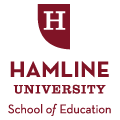Term
Spring 2017
Capstone
Thesis
Degree Name
MAEd
Primary Advisor/Dissertation Chair
Bill Lindquist
Secondary Advisor/Reader One
Melanie Keillor
Peer-Reviewer/Reader Two
Nathan Flansburg
Abstract
The research question was, how I can increase fifth graders’ reading comprehension through the use of higher-order thinking questions and critical thinking? This qualitative action research was based on Anderson, Krathwohl, and Bloom’s (2001) work on the six levels of cognitive thought, Walsh and Sattes’ (2005) and Morgan and Saxton’s (2006) research on quality questioning, and Brookhart’s (2010) critical thinking assessments and rubrics. Their research incorporates into a fifth grade reading classroom while using Fountas and Pinnell’s (2001) guided reading model. The author creates higher ordering thinking questions for three WWII novels. She studies the types of questions and uses a self-reflection rubric to ensure the quality of the questions before asking students to respond online and in guided reading groups. The author also integrates critical thinking lessons. She documents students’ responses to questions and critical thinking lessons using rubrics, evaluating and monitoring comprehension. She concludes that: 1) it is important to provide students modeling, practice, and feedback in all levels of higher order thinking; 2) teachers should self-reflect on their questioning to find their strengths and weaknesses; 3) critical thinking builds a deeper understanding; 4) guided reading discussions allow the students to hear each other’s thoughts and creates opportunities for students to facilitate their own discussions and ask their own questions.
Research Methodology
Action Research
Keywords
Reading, Higher Order Thinking, Critical Thinking, Questioning
Recommended Citation
Samelian, Lindsay A., "How Higher Order Questioning And Critical Thinking Affects Reading Comprehension" (2017). School of Education and Leadership Student Capstone Theses and Dissertations. 4345.
https://digitalcommons.hamline.edu/hse_all/4345

